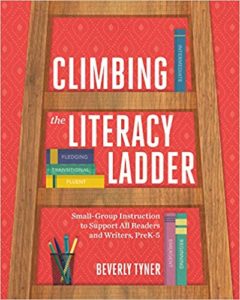Climbing the Literacy Ladder in Grades 4-5
Climbing the Literacy Ladder: Small-Group Instruction to Support All Readers and Writers, PreK–5
By Beverly Tyner
(ASCD, 2019 – Learn more)

Teaching is hard. There, I said it. And elementary teachers have the added difficulty of teaching students how to read.
Historically, the narrative has been that upper elementary teachers don’t need to know how to teach students to read—they work on the reading to learn strategies. However, more and more of our students are needing more from us these days.
Unfortunately, upper elementary teachers don’t always have the literacy knowledge that they need to teach the reading skills their students may need in today’s classrooms.
Good news. In Beverly Tyner’s newest book, Climbing the Literacy Ladder, she addresses this problem. In the introduction she states:
“This book is intended to be a ‘one-stop shop’ for teachers in need of a plan, rationale, and materials to differentiate literacy instruction for all students in prekindergarten through 5th grade.”

Each chapter also includes lesson plan components for that stage, a classroom scenario, strategies and activities to use in your classroom tomorrow, and a description for how to know when to move a student to the next stage. Tyner has also listed the common standards for each stage for fluency, word study, vocabulary, comprehension and writing about reading.
There’s also a chapter on formative assessments that can be used with students, which includes information about rubrics, fluency, running records, word study, vocabulary, comprehension, and portfolios. In addition, there is a clear scope and sequence for word study at each stage.
The lesson plan components, classroom scenarios, strategies and activities for the Beginning-Independent stages were very practical and seemed to be in line with best practices. I can imagine classroom teachers using these tools successfully with their striving readers, even when the teacher is not fully comfortable with the idea of teaching a student at some of the lower stages.
All in all, a practical book, with ready-to-implement ideas for teachers looking for support in their reading instruction.
Pam Hamilton is an intermediate literacy coach in Middlebury, Indiana. She is a trained Reading Recovery teacher and has been in education for over 25 years. She enjoys working alongside teachers as they instill a love of literacy in their students. She also enjoys being wife to Steve and mama to two beautiful daughters, Allie and Peyton.


































